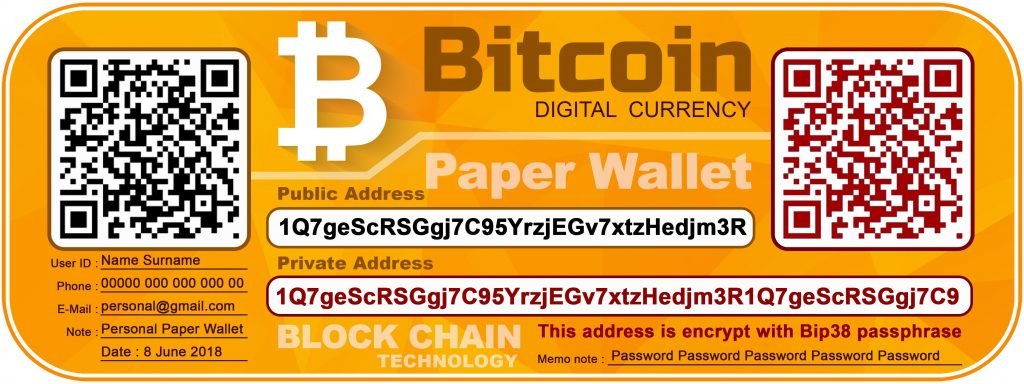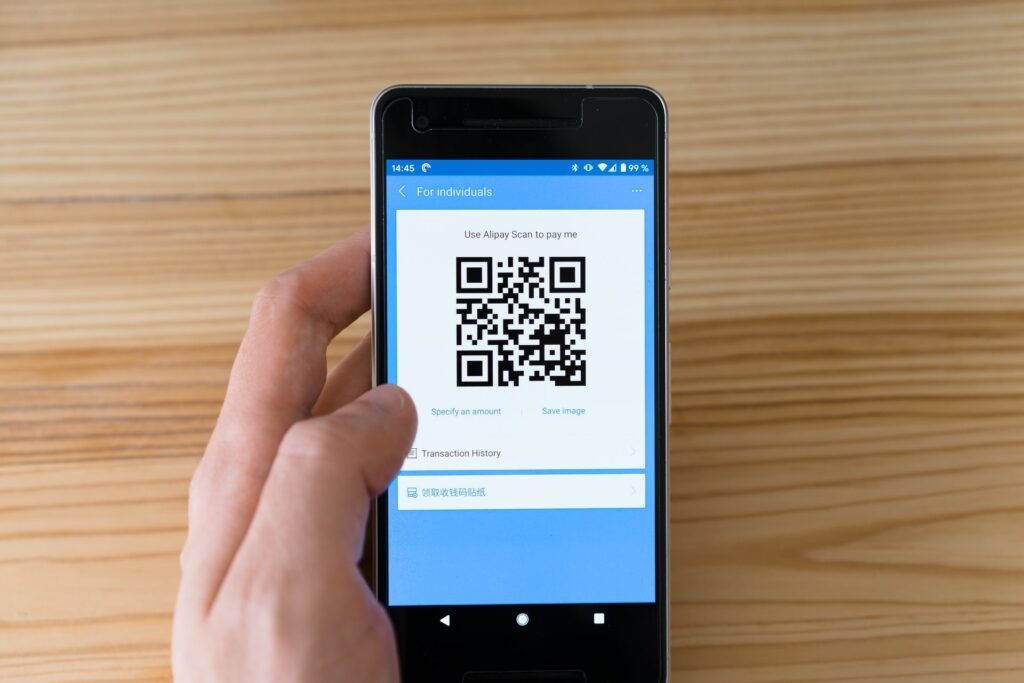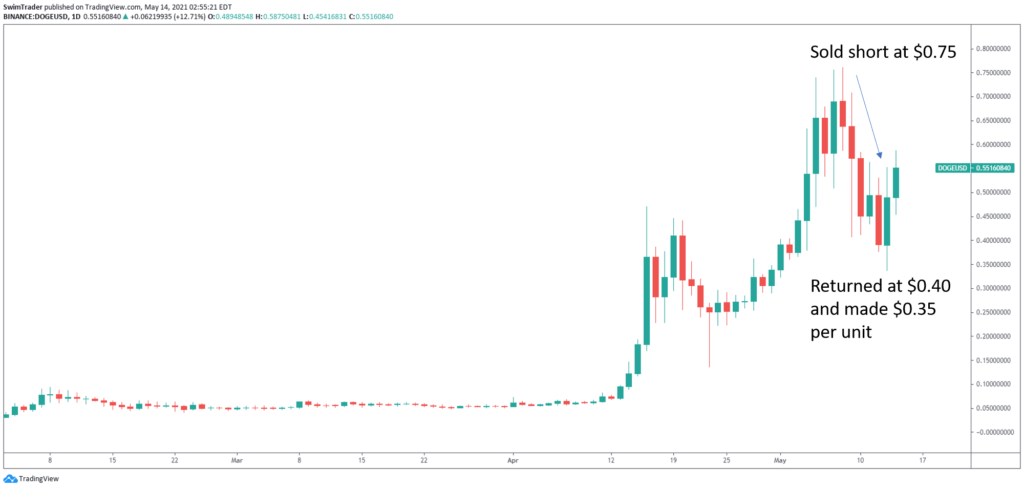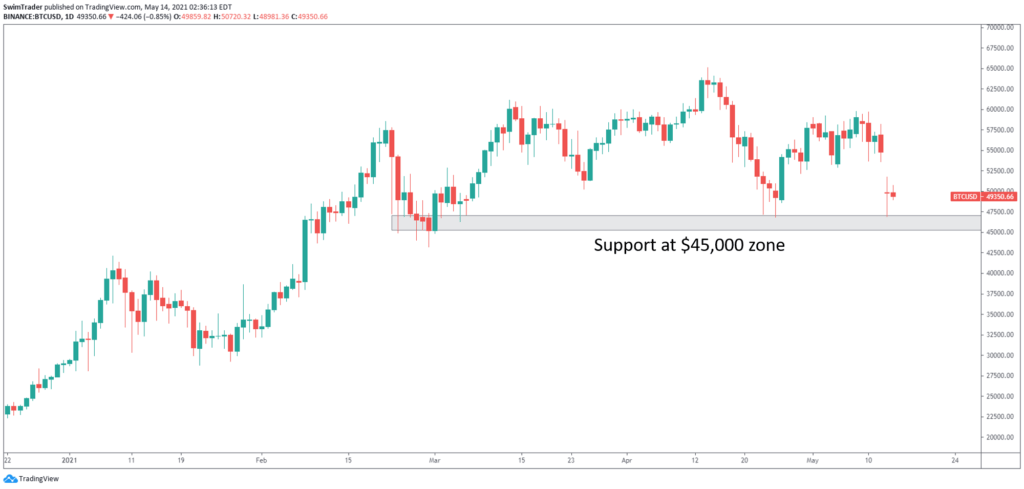In this part, you’ll be exposed to several technical terms. Don’t worry as they are explained in simple words. Are you ready?
P
Paper Wallet: A piece of paper which has your cryptocurrency wallet address, private and public keys, and possibly a QR code printed on it.
A paper wallet is a type of cold wallet as it is not connected to the Internet. What are the benefits of a cold wallet?

Peer-to-peer (P2P): Decentralized interactions between 2 or more parties in a network to share workload or resources.
Permissioned Ledger/Blockchain: A ledger of records or blockchain which can only be viewed by authorized individuals or organizations.
Learn about the major types of blockchains and how they are helpful by clicking here.
Permissionless Ledger/Blockchain: A ledger of records or blockchain which can be by the public.
Phishing: The act of stealing your sensitive information such as password by pretending to be a trusted institution or individual. This could also be carried out through a disguised malware link.
Ponzi Scheme: A scam involving payouts to existing investors using fresh funds from new investors.
Eg. Sunshine Empire, Profitable Group, Bernie Madoff

Portfolio: A collection of cryptocurrencies held by an investor or financial institution.
Pre-mine: A portion or all of a cryptocurrency is generated during or before the public launch.
Price Action: The movement of a cryptocurrency’s price over a period of time.

Price Impact: The movement of a cryptocurrency’s price due to a huge trade volume.
Private Key (aka Secret Key): A string of alphanumeric code to your cryptocurrency that’s meant to be kept secret.

Proof-of-spacetime (PoST): This mechanism requires miners, farmers, and/or validators to provide storage space in their computer for a chance to be rewarded with a cryptocurrency.
Proof-of-stake (PoS): This mechanism requires miners, farmers, and/or validators to lock up their cryptocurrency for a chance to be rewarded with a cryptocurrency.
Proof-of-work (PoW): This mechanism requires miners, farmers, and/or validators to solve mathematical puzzles for a chance to be rewarded with a cryptocurrency.
Protocol: Rules that govern a blockchain.
Pseudonym: A fictitious name.
Eg. Satoshi Nakamoto
Public Address (aka Public Key): The cryptocurrency wallet’s address that you can deposit to. This public address can be made known.
Refer to the image under Private Key.
Pump and Dump (P&D) Scheme: A fraudulent move which inflates the price of a cryptocurrency through misleading statements before cashing out to the public.

Pyramid Scheme: A scam which pays older members using the fees provided by new members.
A Ponzi scheme can be a Pyramid scheme.
Q
QR Code: An encoded square shaped pattern which is made up of black lines.

R
Ransomware: A malware attack on your computer that threatens to destroy or reveal files unless a ransom is paid.

Rekt: A slang describing a huge loss on a trade.
Relative Strength Index (RSI): An indicator used in technical analysis to read the momentum of a cryptocurrency.
Find out about the 3 powerful applications of the RSI here.
Resistance: An upper price zone which prices are unable to break through.
In the chart below, the gray box marks out Bitcoin’s resistance zone.
Understanding the concept of support and resistance is highly beneficial as you’d avoid buying at the top, only to lose money in a bull market.

Return on Investment (ROI): The measure of an investment’s profitability.
Reverse Indicator: A person who is often wrong at predicting price movements of cryptocurrency, to the point that you can use him/her as an indicator to go the opposite direction of his/her trade.
Ring Signature: A type of digital signature which hides the identity of the parties in a transaction.
Roadmap: A timeline of the development plans of a blockchain which affects the cryptocurrency it produces.

Rug Pull: A scam where developers of a blockchain abandon their project and take their investor’s money.
S
Satoshi: The smallest unit of Bitcoin, which is 0.00000001 Bitcoin.
Satoshi Nakamoto: An unknown person or group of persons who invented the Bitcoin blockchain.
Scaling: The ability of a blockchain to handle increasing number of transactions.
Scaling Solution: A solution to help a blockchain handle more transactions as demand rises.
Second-layer Solution: A set of scaling solutions built on top of a public blockchain.
Eg. Lightning Network and Plasma

Securities and Exchange Commission (SEC): An independent agency of the US to regulate and enforce US’ securities markets.
Seed Phrase (aka Mnemonic Phrase): See Mnemonic Phrase.
Sell Wall: A large sell limit order.
SHA-256: A cryptographic hash function that converts inputs into a string of alphanumeric code that has 2 to the power of 256 possible combinations.
Eg. “good morning” becomes “cdf71dea7d7741a2b6f021f3dd344f75c8333988f547866a8fbf28f064cf7c78”
Sharding: A method of scaling which splits the blocks in a blockchain into partitions to reduce the time needed for verifying transactions.
Sharpe Ratio: A ratio to help investors measure ROI against risk.
Shilling: The act of enthusiastically promoting a cryptocurrency.
Shitcoin: A cryptocurrency which doesn’t have potential value or usage.
Short: Borrowing cryptocurrencies to sell because you expect the price of it to continue falling. You’ll return the cryptocurrency at a lower price, earning on the price difference.
Eg. You predict that the price of Dogecoin will fall. You borrow Dogecoins from your broker and sell it to the open market at $0.75.
The price of Dogecoin falls to $0.40 and you decided to return the borrowed Dogecoins, pocketing a profit of $0.35 per coin.

Side Chain: A blockchain ledger that runs in parallel to a primary blockchain with a link between them.
Silk Road: An online black market which has been shut down. It was notorious for accepting Bitcoins as payment.
SIM-swap: A scam involving the scammer calling your telecommunications provider and impersonating you. Messages and calls will then be routed to the scammer’s phone. This include OTPs sent via SMS.
This form of scam could be used in conjunction with phishing to gain access on your sensitive information such as username and passwords to your bank and email accounts, and possibly cryptocurrency hot wallet.
To prevent this, use app-based codes such as Google Authenticator to generate your 2FA.

Slippage: The price difference between the bid or ask and market price when you are buying or selling (respectively) a cryptocurrency.
Smart Contract: A set of governance rules which can facilitate, verify or enforce a contract on the blockchain without external parties.
Soft Cap: The minimum amount an initial coin offering wants to raise.
Soft Fork: A change in software rules where the older blocks are made invalid, but computers running the old rules can still validate the new blocks.
Spot: A cryptocurrency transaction for immediate delivery, payment, or settlement.
Spyware: A malware that records all activities performed on an electronic device.

Stablecoin: A cryptocurrency that’s stable in price because it is usually backed by an asset which isn’t volatile in nature.
BUSD, GUSD, and USDC are just a couple of stablecoins that are backed by USD.
Staking: Locking up your cryptocurrency with an escrow to become a validator in order to earn rewards.
Staking Pool: A pool where stakeholders lock up their cryptocurrency with an escrow to increase their chance of validating a new block for a reward.
Store of Value: A cryptocurrency which can hold its value and exchanged in the future.
Support: A lower price zone which prices are unable to drop below.
In the chart below, the gray box marks out Bitcoin’s support zone.
What makes a good support zone that traders look at? Find out here.

Symbol: The ticker of a cryptocurrency.
Eg. BTC is for Bitcoin, ETH is for Ether, DOGE is for Dogecoin, LINK is for Chainlink.
Here’s What You Can Do To Improve Your Trading Right Now
#1 Register for our market outlook webinars by clicking here
#2 Join us in our Facebook Group as we can discuss the various ways of applying this by clicking here
#3 Never miss another market update; get it delivered to you via Telegram by clicking here
#4 Grab a front row seat and discover how you can expand your trading arsenal in our FREE courses (for a limited time only) by clicking here
See you around!

